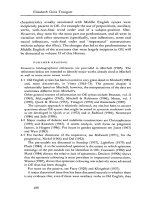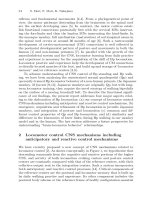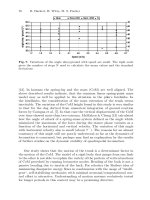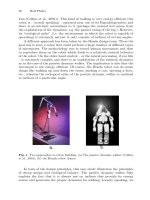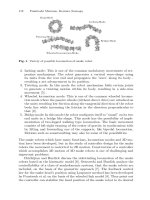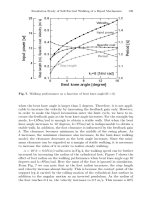Yago et al (eds ) history of the IMF; organization, policy, and market (2015)
Bạn đang xem bản rút gọn của tài liệu. Xem và tải ngay bản đầy đủ của tài liệu tại đây (5.3 MB, 338 trang )
Studies in Economic History
Kazuhiko Yago
Yoshio Asai
Masanao Itoh Editors
History
of the IMF
Organization, Policy, and Market
Studies in Economic History
Series editor
Tetsuji Okazaki, The University of Tokyo, Tokyo, Japan
Editorial Board Members
Loren Brandt, University of Toronto, Canada
Myung Soo Cha, Yeungnam University, Korea
Nicholas Crafts, University of Warwick, UK
Claude Diebolt, University of Strasbourg, France
Barry Eichengreen, University of California at Berkeley, USA
Stanley Engerman, University of Rochester, USA
Price Fishback, University of Arizona, USA
Avner Greif, Stanford University, USA
Tirthanker Roy, London School of Economics and Political Science, UK
Osamu Saito, Hitotsubashi University, Japan
Jochen Streb, University of Mannheim, Germany
Nikolaus Wolf, Humboldt University, Germany
Aim and Scopes
This series from Springer provides a platform for works in economic history that
truly integrate economics and history. Books on a wide range of related topics are
welcomed and encouraged, including those in macro-economic history, financial
history, labor history, industrial history, agricultural history, the history of institutions
and organizations, spatial economic history, law and economic history, political
economic history, historical demography, and environmental history.
Economic history studies have greatly developed over the past several decades
through application of economics and econometrics. Particularly in recent years, a
variety of new economic theories and sophisticated econometric techniques—
including game theory, spatial economics, and generalized method of moment
(GMM)—have been introduced for the great benefit of economic historians and the
research community.
At the same time, a good economic history study should contribute more than
just an application of economics and econometrics to past data. It raises novel
research questions, proposes a new view of history, and/or provides rich
documentation. This series is intended to integrate data analysis, close examination
of archival works, and application of theoretical frameworks to offer new insights
and even provide opportunities to rethink theories.
The purview of this new Springer series is truly global, encompassing all nations
and areas of the world as well as all eras from ancient times to the present. The
editorial board, who are internationally renowned leaders among economic
historians, carefully evaluate and judge each manuscript, referring to reports from
expert reviewers. The series publishes contributions by university professors and
others well established in the academic community, as well as work deemed to be
of equivalent merit.
More information about this series at />
Kazuhiko Yago • Yoshio Asai • Masanao Itoh
Editors
History of the IMF
Organization, Policy, and Market
Editors
Kazuhiko Yago
School of Commerce
Waseda University
Shinjuku-ku, Tokyo, Japan
Yoshio Asai
Faculty of Economics
Seijo University
Setagaya-ku, Tokyo, Japan
Masanao Itoh
School of Social Information Studies
Otsuma Women’s University
Tama, Tokyo, Japan
ISSN 2364-1797
ISSN 2364-1800 (electronic)
Studies in Economic History
ISBN 978-4-431-55350-2
ISBN 978-4-431-55351-9 (eBook)
DOI 10.1007/978-4-431-55351-9
Library of Congress Control Number: 2015940572
Springer Tokyo Heidelberg New York Dordrecht London
© Springer Japan 2015
This work is subject to copyright. All rights are reserved by the Publisher, whether the whole or part of
the material is concerned, specifically the rights of translation, reprinting, reuse of illustrations, recitation,
broadcasting, reproduction on microfilms or in any other physical way, and transmission or information
storage and retrieval, electronic adaptation, computer software, or by similar or dissimilar methodology
now known or hereafter developed.
The use of general descriptive names, registered names, trademarks, service marks, etc. in this publication
does not imply, even in the absence of a specific statement, that such names are exempt from the relevant
protective laws and regulations and therefore free for general use.
The publisher, the authors and the editors are safe to assume that the advice and information in this book
are believed to be true and accurate at the date of publication. Neither the publisher nor the authors or the
editors give a warranty, express or implied, with respect to the material contained herein or for any errors
or omissions that may have been made.
Printed on acid-free paper
Springer Japan KK is part of Springer Science+Business Media (www.springer.com)
Preface: The IMF and the Postwar International
Financial Order
This book aims to examine the foundation and evolution of the post-WWII international financial order, focusing on the International Monetary Fund (hereafter IMF).
The volume deals mainly with the period from the start of the IMF in 1947 until the
beginning of the 1960s, when the institution fully exercised its functions. In order to
demonstrate our basic standpoint, let us examine previous studies on selected topics
regarding this subject.
The Gold Standard and After: Was the Bretton Woods
System an “Innovation”?
An understanding of the classical international gold standard as well as the interwar
gold exchange standard is indispensable in putting the postwar international financial system in a larger historical context. Representative studies on the pre-WWI
international gold standard describe it as a sort of global public good for peripheral
countries, without any artificial structure (Bordo 1984; Kindleberger 1986). It was
also a “Good Housekeeping Seal of Approval” for peripheral countries to access
capital flows from the industrialized core regions (Bordo and Rockoff 1996).
Following this view, official international cooperation on money and exchange had
been promoted only in a limited scope during the gold standard era: a debate
between Barry Eichengreen and Marc Flandreau sharply revealed this point
(Eichengreen 1995; Flandreau 1997). Why could this gold standard operate without
a legal structure and formal collaboration? Historians often refer to a “silent rule” or
“rules of the game” that unofficially regulated the gold standard regime, although a
great variety of views are still left among historians as for function of this “rules of
game” (Bordo 1984). During the interwar period, the move toward international
collaboration on money and exchange emerged but stayed in a burgeoning stage: the
Tripartite Monetary Agreement in 1936 took steps toward exchange stability
v
vi
Preface: The IMF and the Postwar International Financial Order
through international collaboration, but it could not bring about results through
collaboration in the true sense of the word (Eichengreen 1992; Mouré 2002).
In contrast, the international monetary system founded by the Bretton Woods
Conference during the late WWII period was, after Harold James, an “innovation”
that emerged in the middle of the twentieth century, for the system involved a rule that
could limit national sovereignty in exchange-rate and macroeconomic policies (James
1996, p. 9). The Bretton Woods Conference (officially the International Monetary
and Financial Conference of the United and Associated Nations) was held in Bretton
Woods, New Hampshire, the United States, 1–22 July 1944, with 44 participating
countries. The Conference approved the final statement as well as the Agreements of
the IMF and the International Bank for Reconstruction and Development, known as
the World Bank (hereafter WB). Both Agreements of these institutions went into
effect on 27 December 1945. After the founding assemblies of both institutions in
March 1946, the WB opened its doors on 25 June 1946 and the IMF on 1 March
1947. The Bretton Woods system thus was created both artificially and officially.
However, the above-mentioned antagonism between the “silent rule” under the
gold standard era and the “innovation” in the Bretton Woods System invokes, from
our perspective, some questions: was the “silent rule” so automatically effective,
and was the “innovation” such a new attempt? In fact, the “silent rule” for the participating countries in the gold standard system was not “silent” in the sense that
central banks actively coordinated their bank rates in order to neutralize the negative
effect of business cycle contagion (Toniolo 1988; Borio et al. 2008). The Bretton
Woods System was also a product of diplomatic negotiation, often with obscure
concessions (Steil 2013; Helleiner 2014). It is therefore hard to distinguish these
systems, gold standard as an automatic market-based one and the Bretton Woods
system as a legal-based one.
Our research in this volume attempts to cast doubt on the view of the Bretton
Woods System as an “innovation” and to positively present an alternative historical
view referring to a certain continuity in terms of the political character of the systems, in between the prewar and the postwar international financial orders. In the
following chapters, we approach the rule-making process of the IMF from the viewpoint of international politics. In the IMF during the fixed-rate era, the countries
with surplus international balances were privileged, while deficit countries were
sanctioned, and socialist countries were kept aside. This system, however, was not
set up this way from the beginning: the rules on lending and the Article 14 consultation had been elaborated upon through a struggle among member countries. This is
why we focus on politics in the rule-setting phase during the 1950s, in which period
the institutional framework of the IMF was set up.
Bretton Woods, System or Order?
An article by Michael Bordo, which represents a commonly accepted view on the
Bretton Woods monetary system, asks “why Bretton Woods was statistically so
stable and why it was short lived?” (Bordo 1993, p. 4). In fact, the IMF had 12 years
Preface: The IMF and the Postwar International Financial Order
vii
of preparation before beginning to function fully and less than 10 years of heyday
from 1959 to 1967. The answer according to Bordo was that the weakness of the
Bretton Woods System was due to the system’s having been built by combining the
gold exchange standard on the one hand and the adjustable peg system on the other.
The system depended solely on the United States and thus when the United States
gave up its price stability policy in late 1960s, the system was led to collapse. The
above interpretation of the Bretton Woods System by Bordo stands on the presupposition that the core of the System had been a fixed-rate system.
Contrary to above conventional views, international political economist David
Andrews recently proposed the notion of the “Bretton Woods Order”. Andrews
made a distinction between the Bretton Woods System as an officially established
international monetary system and the Bretton Woods Order as an unofficial international economic order: according to his thesis the Bretton Woods System collapsed but the Bretton Woods Order is still evolving until the present (Andrews
2008). The system built by the Bretton Woods Conference was, according to
Andrews, an economic order seeking two goals at once: domestic economic policy
and international trade development. Thus the objectives of the Bretton Woods
Order stayed unchanged after the end of the Bretton Woods System as a monetary
system (i.e., a fixed-rate system). In fact, he says, trade liberalization is still ongoing, without a thorough return to protectionism.
Andrew’s view is inspired by the “embedded liberalism” thesis of John Ruggie
(1982). This Ruggie theory, influential among international political scientists,
describes post-WWII liberalism as a product of compromise between economic
nationalism and multilateral economic liberalism, the latter totally different from
the nineteenth-century liberalism. The interwar period gold standard collapsed,
according to Ruggie, not because of the absence of a hegemon country but due to
the leading states’ lack of power to coordinate market forces to respond to social
requirements. However, with agreement on the Atlantic Charter in 1941, two goals,
namely, multilateralism for free trade on the one hand and domestic economic
development with social insurance on the other, have been combined, to be incarnated in the Bretton Woods Agreement as well as the General Agreement on Tariffs
and Trade (hereafter GATT). Even after the suspension of gold–dollar exchange in
1971, free trade is still developing. Moreover, Ruggie says, the flexible rate system
has been introduced in order to avoid the contradiction between international macroeconomic policy and the international monetary system per se, which indicates
the continuity of the double political goals of the Bretton Woods System. Ruggie’s
views has been echoed recently by Abdelal, who stresses European leadership in
capital movement liberalization, as an example of the Ruggie thesis (Abdelal 2007).
This book shares the view of Ruggie and Andrews regarding historical continuity
before and after introduction of the floating system in the early 1970s; however, the
approach differs: our book pays special attention to the evolution of the international
monetary system as an international public good, and above all the role played by
the IMF. In our hypothesis, the IMF and the international market have not been
“embedded” in a social order in Ruggie’s sense; they had their own logic of evolution, influenced by economic and monetary conditions, at home as well as
overseas.
viii
Preface: The IMF and the Postwar International Financial Order
The Bretton Woods System and National Economies
During the late half of the nineteenth century, the European and American nation
states were establishing their proper domestic currency systems, and this domestic
process went along with the formation of an international system of settlements
based on the gold standard (Helleiner 2003). This means that, as recent historical
studies have made clear, the international gold standard had been supported by the
development of domestic currency systems, not by the gold bullion itself. As Robert
Triffin stated, “the nineteenth century could be far more accurately described as the
century of an emerging and growing credit-money standard, and of the euthanasia
of gold and silver moneys, rather than as the century of the gold standard” (Triffin
1968, p. 21). In Japan as well, concessional trade during the late Tokugawa
Shogunate and the early Meiji period had been settled by silver, but this was replaced
soon after by the settlement by exchange bills following the establishment of the
Yokohama Specie Bank. Finally the Japanese currency system was integrated into
the international gold standard in 1897, along with the elaboration of the domestic
currency system with the foundation of the Bank of Japan (1882) and the Convertible
Bank Note Act (1884) (Ishii 1994).
Compared to the above achievements in financial history during the gold standard era, the relations between the international system and national economies in
the Bretton Woods period still remain unclear. Was the international system stipulated in the Bretton Woods Agreement so powerful in shaping the postwar national
economies, at least in the industrialized West? Did the postwar international financial system support the unprecedented growth of the capitalist world, or did the
growth itself make the international system sustainable? Our study tries to answer
these questions, focusing mainly on the tension in the rounds on exchange restrictions and lending between the IMF and member countries. It is also worth noting
that before 1950 the only surplus country was essentially the United States, but in
1960 the situation totally changed with the US recording overall deficits of international accounts: the book also deals with the redefining of the system under the
above changes that took place in the national economies.
Together with the above approach to the national economies, we pay special
attention to the relation of the IMF with the markets. The counterparts for the IMF’s
operations being the member countries’ exchange agencies, the Fund did not have
official contact with the markets. Nevertheless, the IMF had to watch the movements of the markets carefully: The IMF’s commitment to the pound sterling during
the 1940s and the 1950s as well as the approval of the European Payments Union as
opposed to the original ideal of the IMF were products of the Fund’s recognition of
the realities of the markets selecting their proper currencies of settlement. Moreover,
as Chap. 6 explains, the IMF examined the use of international short-term capital
markets to cope with the international liquidity problem. The above “marketoriented” aspect of the IMF is one of the major findings of this volume, as a critique
of the Ruggie–Andrews thesis that treats the IMF mainly from the “embedded”
social context, ignoring market conditions and constraints.
Preface: The IMF and the Postwar International Financial Order
ix
The IMF as One of the Actors, but an Independent One
Finally, we try to provide an answer to the following question: Whose role was the
most decisive in the working of the Bretton Woods System: the IMF, the United
States, or someone else? Our hypothesis is that the postwar international financial
system was an amalgam produced by several actors, in which no participants could
maintain their hegemony over the system. In order to approach this issue, our book
places the role of the IMF in relation to the international monetary and the financial
system as a whole, i.e. with other institutions and treaties. Although the IMF has
been the central focus of the post-WWII international monetary system, the position
of the IMF has changed from its foundation to the present: although the IMF was a
main actor of the fixed-rate system, it was not even a supporting actor during the
Marshall Plan period, and after the mid-1960s its initiative has been taken over by
the G10. From our point of view, the work on the IMF by Harold James, a quasiofficial history of the institution, could be criticized for describing the IMF as the
main actor in the system at all times (James 1996). Contrary to this “IMF-centrism,”
recent historical studies on the Bank for International Settlements are trying to
introduce an alternative view (Toniolo 2005; Yago 2013). Of course, all the “official” IMF histories, from Horsefield (1969) to De Vries (1986), and above all James
(1996) and Boughton (2001) were very useful for our research, leading us to insightful topics. Our approach, however, differs from those official historians in putting
the IMF in the midst of plural powers and interests, often from the points of view of
member countries. In light of the above current of studies, this book approaches the
IMF from multiple hypotheses to critique such an “IMF-centric” history. Although
very important, the IMF was just one of the actors in the postwar international
financial order.
On the other hand, we pay attention to the autonomous character of the IMF as
an institution. The fact that the United States maintains its veto over important decision making in the IMF often leads to an image that the US could drive this institution freely, a view that of course is backed by some solid evidence. However, once
established, the IMF as an institution generated its own interests and logic in policymaking, and the staff headed by the Managing Director represented those interests
and logic. The US Government, on the other hand, did not represent one single
interest: inside the government were plural antagonisms, between the Department
of State and the Department of the Treasury, and even within the Treasury. We must
also keep in mind the relation between the US Government and the Congress
(Lavelle 2011). The American veto over IMF decisions, therefore, did not mean the
dependence of the IMF on the US Government. Moreover, for the United States, the
IMF was not the only gateway to the international financial arena. In this context,
the work of Jeffrey Chwieroth, which pointed out an organizational change “from
within” the IMF, has inspired our approach (Chwieroth 2010). After all, the IMF
must be regarded as an independent actor.
x
Preface: The IMF and the Postwar International Financial Order
Conclusion
In sum, our standpoint is simple and clear: the financial history approach, represented by Bordo, Eichengreen, or Flandreau, leans too much towards economics
based explanation; the international political science approach, guided by Ruggie
and Andrews, depends too much on historical or anecdotal description. The former
approach describes history by logic, the latter develops logic by history; the former
places less emphasis upon human networks, the latter pays less attention to markets
and structural constraints. Our volume tries to synthesize the above two approaches,
combining the strengths of both, relying upon archival sources.
Every chapter in this book explores archival sources, mainly from the IMF
Archives but also from the national archives of the governments involved (the
United States National Records and Archives, the Public Record Office of the United
Kingdom, Archives Nationales de France, the Japanese Government Archives, etc.)
as well as those of the central banks (the Bank of England, Banque de France,
Bundesbank, Banca d’Italia, the Bank of Canada, the Bank of Japan, etc.).
Tokyo, Japan
Yoshio Asai
Kazuhiko Yago
References
Abdelal, Rawi. (2007). Capital Rules, the construction of global finance. Cambridge: Harvard
University Press.
Andrews, David M. (2008). Orderly change: international monetary relations since Bretton
Woods. Ithaca: Cornell University Press.
Bordo, Michael D. (1984). The gold standard: the traditional approach. In A Retrospective on the
classical gold standard, ed. M.Bordo and A.Schwartz. Chicago: The University Chicago Press.
Bordo, Michael D. (1993). The Bretton Woods international monetary system: A historical overview. In A Retrospective on the Bretton Woods system, ed. M. Bordo and B. Eichengreen.
Chicago: The University Chicago Press.
Bordo, Michael D., and Hugh Rockoff. (1996). The gold standard as a “Good housekeeping seal
of approval”. The Journal of Economic History 56(2): 389–428.
Borio, Claudio, Toniolo Gianni., and Clement Piet. (2008). Past and future of Central Bank
Cooperation. New York: Cambridge University Press.
Boughton, James. (2001). Silent Revolution, the International Monetary Fund, 1979–1989.
Washington: International Monetary Fund.
Chwieroth, Jeffrey. (2010). Capital Ideas, the IMF and the rise of financial liberalization.
Princeton: Princeton University Press.
De Vries, Margaret. (1986). The IMF in a changing world, 1945–85. Washington, DC: International
Monetary Fund.
Eichengreen, Barry. (1992). Golden Fetters: The gold standard and the great depression, 1919–
1939, NBER series on long-term factors in economic development.
Eichengreen, Barry. (1995). Central banks cooperation and exchange rate commitments: The classical and interwar gold standards compared. Financial History Review 2(2): 99–117.
Flandreau, Marc. (1997). Central bank cooperation in historical perspective: A sceptical view.
Economic History Review (50): 735–763.
Preface: The IMF and the Postwar International Financial Order
xi
Helleiner, Eric. (1994). States and the reemergence of global finance. Ithaca: Cornell University
Press.
Helleiner, Eric. (2003). The Making of national money. Ithaca: Cornell University Press.
Helleiner, Eric. (2014). Forgotten foundations of Bretton Woods, international development and
the making of the postwar order. Ithaca: Cornell University Press.
Horsefield, J. Keith. (1969). The International Monetary Fund, 1945–1965, vols. 1–3. Washington,
D.C.: IMF.
Ishii, Kanji. (1994). Japanese foreign trade and the Yokohama Specie Bank, 1880–1913. In Pacific
banking, 1859–1959: East meets West, ed. Olive Checkland, Shizuya Nishimura., and Norio
Tamaki. London: St. Martin’s Press.
James, Harold. (1996). International monetary cooperation since Bretton Woods. Oxford: IMF &
Oxford University Press.
Kindleberger, Charles P. (1986). International public goods without international government.
American Economic Review 76(1): 1–13.
Lavelle, Katheryn C. (2011). Legislating international organization, the US Congress, the IMF,
and the World Bank. New York: Oxford University Press.
Mouré, Kenneth. (2002). The Gold standard illusion, France, the Bank of France, and the international gold standard, 1914–1939. Oxford: Oxford University Press.
Ruggie, John Gerard. (1982). International regimes, transactions, and change: Embedded liberalism in the postwar economic order. International Organization 36(2): 379–415.
Steil, Benn. (2013). The battle of Bretton Woods: John Maynard Keynes, Harry Dexter White, and
the making of a new world order. Princeton: Princeton University Press.
Toniolo, Gianni, ed. (1988). Central banks’ independence in historical perspective. Berlin/New
York: W. de Gruyter.
Toniolo, Gianni. (2005). Central bank cooperation at the Bank for International Settlements,
1930–1973, with the assistance of Piet Clement. New York: Cambridge University Press.
Triffin, Robert. (1968). Our International Monetary System: Yesterday, today and tomorrow.
New York: Random House.
Yago, Kazuhiko. (2013). The Financial history of the Bank for International Settlements. London:
Routledge.
Contents
Part I
1
Foundation and Development of the IMF
Pre-history of the IMF: Debates in the UK
and Anglo-American Negotiation ..........................................................
Masanao Itoh
3
2
U.S. International Monetary Policy for the IMF..................................
Isao Suto
25
3
Shaping the Fund’s Policy for Exchange Liberalization .....................
Teru Nishikawa
47
4
“Maybe the Fund needs something else.” Per Jacobsson,
from the Bank for International Settlements to the International
Monetary Fund, 1931–1963....................................................................
Piet Clement
5
6
International Liquidity Problems in the 1960s:
The Examination of the Minutes of the Executive Board
of the International Monetary Fund .....................................................
Yasutoshi Noshita
95
Restoration of European Currency Convertibility and Securing
International Liquidity: The IMF and Key Currencies ...................... 125
Masayoshi Tsurumi
Part II
7
67
IMF in Relation to National Economies and International
Organizations
The IMF and France (1944–1960): A “Cooperative Game”
in the Bretton Woods System ................................................................. 147
Kazuhiko Yago
xiii
xiv
Contents
8
The IMF and Germany: Currency Crisis
and Exchange Rate Policy ...................................................................... 165
Ayako Ishizaka
9
The IMF and Italy: Trade Liberalization
and Return to Convertibility .................................................................. 185
Kanna Ito
10
The IMF and Canada: From Floating to Fixed Exchange Rates ....... 207
Ayumu Sugawara
11
Japan’s Participation in the IMF and Settlement
of Its Prewar Foreign Debt ..................................................................... 225
Makoto Kishida
12
The IMF and Japan: Liberalization of Foreign
Exchange and Pursuit of High Growth ................................................. 249
Yoshio Asai
13
China and the International Monetary Fund 1945–1985 .................... 275
Catherine R. Schenk
Epilogue: How Should We View the Transformation of the IMF?
Looking at the Collapse of the Bretton Woods System ................................ 311
Index ................................................................................................................. 319
Biographies
Editors
Yoshio Asai is a Professor of Economic History at Seijo University. He is the author
of Sengo Kaikaku to Minshushugi (Post-war Economic Reforms and Democracy)
(2001) and a co-author of Showa Zaiseishi, 1952–73 (History of Fiscal and Monetary
Policies in Japan, 1952–73), Vol. 11 (1999), Vol. 12 (1992) and Kinyu Kiki to
Kakushin (Financial Crises and Innovations) (2000).
Masanao Itoh Professor at Otsuma Women’s University and Professor Emeritus at
the University of Tokyo. His main writings are Japanese Overseas Finance and
Financial Policy 1914–1936 (Nagoya University Press, 1989, in Japanese), which
was awarded the 31st Japan Economist Prize in 1990; History of Fiscal and
Monetary Policies in Japan 1974–1989, Vol. 7, 11: International Finance and
External Economic Affairs (Ministry of Finance, Toyo Keizai Inc., editor, 2003,
2004, in Japanese); Japanese Overseas Finance and Financial Policy 1945–1974
and The Formation and the End of the 360 Yen–Dollar Rate (Nagoya University
Press, 2009, in Japanese); and Why Have the Financial Crises Been Repeated?
(Junpo-sha, 2010, in Japanese).
Kazuhiko Yago, Professor at Waseda University, Faculty of Commerce, defended
his doctoral dissertation “L’épargne populaire comme fonds de placement public:
Caisse des Dépôts et Consignations” at Université Paris X in 1996. Publications
include: Asian Imperial Banking History (with Hubert Bonin and Nuno Valério),
(Pickering and Chatto, 2014); The Financial History of the Bank for International
Settlements (Routledge, 2012); and “La Banque du Japon dans le système monétaire international, 1945–1985”, in Olivier Feiertag et Michel Margairaz, dirs., Les
banques centrales à l’échelle du monde (Presses de la Fondation nationale des
sciences politiques, 2012).
xv
xvi
Biographies
Authors
Piet Clement currently works as historian and head of the Library and Archives unit
at the Bank for International Settlements in Basel, Switzerland. He obtained a Ph.
D. in Modern History at the Katholieke Universiteit Leuven, Belgium in 1995, with
a dissertation on Belgian public finance (1830–1940). His papers include: “Nazi
Germany and the service of the Dawes and Young Loans” (Financial History Review
11(1): 33–50); “The term ‘macroprudential’: origins and evolution” (BIS Quarterly
Review, March: 59–67); “A balancing act: 75 years of international monetary and
financial cooperation, 1936–2011” (Revue bancaire et financière, 2010:7–8; 2011:
386–393).
Ayako Ishizaka, Professor at Aichi Shukutoku University, Faculty of Business. She
studied economic history and received her doctorate in economics in 2000 from
Nagoya University. Her publications include: “Disequilibrium between National
and International Economic Accounts in the 1950s West Germany: Dilemma of the
‘Social Market Economy’”, in Gonjo, Yasuo, ed., Neo-Liberalism and the Post-War
Capitalism: The European and American Experiences from Historical Perspectives
(Nihon Keizai Hyouronsha, 2006, pp. 255–299); and “From Regional Surplus
Nation to Global Capital Exporter: German as an Article XIV Member of the IMF
(1952–1961), in Rekishi to Keizai (Journal of Political Economy and Economic
History), 217 (Vol. LV, No. 1), Autumn 2012, pp. 1627.
Kanna Ito is an Associate Professor of St. Andrew’s University, Faculty of
Economics. She received her doctorate in economics in 2001 from Nagoya
University. Her publications include: “Economic Revitalization and Birth of the
State Ownership in Interwar Italy,” in Economic Science, Nagoya University, 2008,
vol. 56; “Foundation of the Post-war Italian Economy: Formation of the 1936
Banking Law and the State Holdings Company”, in Isao Hirota et al. eds., Social
and Economic Policy of Contemporary Europe: Formation and Evolution (Nihon
Keizai Hyouronsha, 2006); “Industrial Relief in Italy under the Great Depression:
SIP Group Dissolution by the IRI,” in Journal of Political Economy and Economic
History, 2001, no. 172.
Makoto Kishida is an Assistant Professor of Japanese Economic History in the
College of Economics at Nihon University. He has written articles on the history of
Anglo-Japanese/US-Japanese financial relations in the twentieth century. He is coauthor of Nihon Keizaishi, 1600–2000 (Economic History of Japan, 1600–2000)
(Keio University Press, 2009). His recent publications include papers on Japan’s
foreign loan issues and its credit in the international capital market before the World
War II.
Biographies
xvii
Teru Nishikawa is an Associate Professor of Economics at Yokohama National
University. He holds a PhD in Economics from the University of Tokyo, Japan. He
is the author of Creation and Evolution of the IMF Economic Policy in the Bretton
Woods Era (The University of Nagoya Press, 2014).
Yasutoshi Noshita is a Professor in the faculty of Political Science and Economics,
Kokushikan University. He is the author of the book Contemporary Development of
Monetary Economic Analysis: In Search of the Managed Currency System of nonKeynesian Type (in Japanese) (Nihon Keizaihyouronsha, 2001).
Catherine Schenk, FRHS, is Professor of International Economic History at the
University of Glasgow. She gained her Ph.D. at the London School of Economics
and has held academic posts at Royal Holloway, University of London, Victoria
University of Wellington, and visiting positions at the International Monetary Fund
and the Hong Kong Monetary Authority as well as the University of Hong Kong and
Nottingham Business School campus in Seminyeh, Malaysia. She is an associate
fellow in the international economics department at Chatham House in London. Her
research focuses on international monetary and financial relations after 1945 with a
particular emphasis on East Asia and the United Kingdom. She is the author of several
books including International Economic Relations since 1945 (2011) and The
Decline of Sterling: Managing the Retreat of an International Currency (2010). Her
current research interests include the development of international banking regulation since the 1960s and the causes of the sovereign debt crisis of the 1980s.
Ayumu Sugawara is an Associate Professor of Global Business History at Tohoku
University. He obtained his Ph.D. in Economics from Kyoto University. His papers
include “British Overseas Investments in Canada in the 1950s” (Shakai-Keizai
Shigaku, Vol. 66, No. 2, 2001, in Japanese); “N.M. Rothschild & Sons’ Mining
Investments, 1952–1960” (Keieishigaku, Vol. 36, No. 1, 2001; in Japanese; and
“American International Banking in Asia: The Case of IBC in China during the
Inter-War Period” (Keizaigaku, Vol. 74, No. 4, 2014).
Isao Suto is a Professor of Economic History at Meiji University, Tokyo. He gained
his Ph.D. in Economics from Nagoya University. His books include Shaping of the
Post-War Federal Reserve Policy: From New Deal to the Accord (2008).
Masayoshi Tsurumi is a Professor in the Department of Economics, Hosei
University. He obtained a Ph.D. from the Department of Economics at the
University of Tokyo.
Abbreviations
BA
BIS
BOE
ECA
ECAFE
ECOSOC
EMA
EPU
ERP
EXIM
FOMC
FRB
FRBNY
G10
GAB
GATT
IBRD
IDA
IMF
ITO
KMT
MSA
MSA
NAC
NSC
OECD
OEEC
PRC
ROC
SDR
Banker’s acceptance
Bank for International Settlements
Bank of England
Economic Cooperation Administration
Economic Commission for Asia and the Far East
Economic and Social Council of the United Nations
European Monetary Agreement
European Payments Union
European Recovery Program
Export-import Bank of Washington
Federal Open Market Committee
Board of Governors of Federal Reserve System
Federal Reserve Bank of New York
Group of Ten
General Agreement to Borrow
General Agreement on Tariffs and Trade
International Bank for Reconstruction and Development (see WB)
International Development Association
International Monetary Fund
International Trade Organization
Guomintang (Chinese Nationalist Party)
Mutual Security Act
Mutual Security Agency
National Advisory Council on International Monetary and Financial
Problems
National Security Council
Organization for Economic Cooperation and Development
Organization for European Economic Cooperation
People’s Republic of China
Republic of China
Special Drawing Rights
xix
xx
UN
UNCTAD
WB
WP3
Abbreviations
United Nations
United Nations Conference on Trade and Development
World Bank (see IBRD)
OECD Economic Policy Committee Working Party Three
Part I
Foundation and Development of the IMF
Chapter 1
Pre-history of the IMF: Debates in the UK
and Anglo-American Negotiation
Masanao Itoh
1
Introduction
According to a study by the IMF released in September 2008, around the time of the
economic shock that followed the collapse of Lehman Brothers, over the 38-year
period from 1970 through 2007 currency crises had occurred in 208 countries, bank
crises in 124 countries, and national debt crises in 63 countries.1 Since the 1970s
financial crises had occurred in a wide variety of countries and regions—in developed countries, emerging newly industrialized states, and developing countries, and
in Asia, Europe, North and South America, and Africa. Under such conditions, the
Washington consensus and the role of IMF conditionality became a subject of
consideration anew, as well as reconsideration of the role of the IMF in recent great
moderation era.
In the 2009 G20 meeting in London, then-British Prime Minister Gordon Brown
stated, “The old Washington consensus is over.” Many argue that the Washington
consensus arose in the 1970s with the exit of Keynesianism, spread during the
1980s, peaked in the 1990s, and either came to an end in the 2000s or survived until
the global financial crisis of 2008 and 2009. One also could say that questions are
being asked again about how to restore confidence in international institutions
themselves or in the policies they propose.
In doing so, the age of the IMF system as an adjustable peg system, or the age of
the so-called Bretton Woods system, often is mentioned as a standard of comparison. Since the subjects discussed at G20 meetings after the Lehman Brothers shock,
such as whether a new reserve currency or intermediate currency should be created,
1
IMF, WP08/224, Systemic Banking Crises: A New Database.
M. Itoh (*)
School of Social Information Studies, Otsuma Women’s University,
Tama, Tokyo 206-8540, Japan
e-mail:
© Springer Japan 2015
K. Yago et al. (eds.), History of the IMF, Studies in Economic History,
DOI 10.1007/978-4-431-55351-9_1
3
4
M. Itoh
how to regulate movement of capital, means of providing funds to countries faced
with funds shortages, and supervision and regulation of private financial institutions, are the same topics discussed when forming the Bretton Woods system, it is
not unexpected that the period of formation of the Bretton Woods system would
emerge as a standard of comparison.
Already an extremely large number of topics related to the formation of the
Bretton Woods system have been discussed. Among these, the view of Harrod
(1951) and Gardner (1969) have served as standards for a very long period of time.
This is the view that, despite the Keynes’ proposal was superior to the White’s, the
Keynes proposal of a credit-creation function and a multilateral settlement system
based on banking principles was defeated by the White’s proposal based on the
principle of contribution, which did not involve any particular credit-creation function or settlement system, due to the overwhelming economic power of the United
States and wartime financial relations between the U.S. and Great Britain (in which
debtor nation status, fiscal insolvency, and a current account deficit led to accumulation of pounds sterling).
However, the 1970s saw the beginning of opposition to this Keynesian myth. The
fuse was lit by T. Balogh (1976), whose criticisms advanced through both focusing
on the historical limitations of the Keynes’ plan and reconsidering the U.S. proposal. Behind this development was progress in materials, such as the publication of
Keynes’ complete works and disclosure of primary materials in both Britain and the
U.S., as well as criticism of Keynesian economics from the points of view of monetarism and rational expectations theory, which saw stagflation which commonly
occurred in many developed nations as a result of Keynesian policies.
Regarding the first point, a focus on the historical limitations of the Keynes plan,
A. van Dormael (1978) argued that there was continuity between the Keynes plan
and Nazi bilateral settlement agreements, while R.F. Mikesell (1994) argued for the
transitional nature of the multilateral settlement concept premised on an exchange
concentration system. Also, D.E. Moggridge (1986), who conducted a detailed
comparison with the age of the international gold standard, identified two abstract
views of Keynes—one as a regulationist who argued for control through rules (in
response to nonconformity between international finance and international economic policies)—and one as an elasticity pessimist. R. Skidelsky (2002) abstracted
an image of Keynes as a defender of British interests. On the contrary, G.C. Peden
(2004), through primary materials of the HM Treasury, revealed that Keynes’ idealism brought conflicts repeatedly with the HM Treasury and the Bank of England in
various scenes. Recently, as seen in Shigeru Yonekura (2006), the view also has
arisen that Keynes had little understanding of the IMF Articles of Agreement.
The latter point, the review of the American proposal, saw a transition from
R.F. Harrod’s (1951) mythicized view of White as a believer in Keynesianism to
R.W. Oliver’s (1975) view of White’s proposal as no more than an offshoot of the
Inter-American Bank proposal and the image of White identified by S.W. Black
(1991) as a person deeply opposed to Treasury Secretary Morgenthau and Treasury
Principal Economist Bernstein (the first Director of the IMF Research Department).
1
Pre-history of the IMF: Debates in the UK and Anglo-American Negotiation
5
Furthermore, in recent years the view even has appeared that White was a Soviet
spy, as argued in J.E. Haynes and H. Klehr (1999).2 In contrast, J.M. Boughton
(2006) has expressed the opposite view that not only had Morgenthau continued to
trust White but that his innovative, flexible, and future-oriented economic thought
played a decisive role in the design of the IMF. Furthermore, from an extensive
review of a large number of White’s unpublished documents B. Steil (2013) has
depicted him as a designer of the postwar order from his perspective as a patriot and
defender of American interests.
Even today the fundamental issues of these arguments over the process of creation of the IMF system remain unresolved. The main reason for this can be thought
of as the fact that even today there is insufficient understanding of the points of how
the Allies’ postwar plans resulted in the structure of the IMF, where among these
plans the Allies were fundamentally in opposition to each other, and how this opposition was reflected in the agreement. This work will reconsider these points by
looking mainly at the process of formation of the Keynes and White plans during
the period prior to the Bretton Woods Agreements and identifying various confrontations that emerged during that process.
2
2.1
What Were the Disputes?
The Allies’ Postwar Plans
It is well known that the Allies’ postwar plans appeared in the August 1941 Atlantic
Charter and the February 1942 Anglo-American Mutual Aid Agreement. Put simply, these postwar plans intended to realize the two goals of “freedom, nondiscrimination, and multilateralism” and “expanding equilibrium (economic recovery and
full employment through expansionism)” among the Allies through international
partnership and cooperation. However, it is not necessarily the case that there was a
consensus, either among the Allies or domestically in the U.S. or Britain, of how
such freedom, nondiscrimination, and multilateralism should be understood or how
these three ideals should be linked to expanding equilibrium.
For example, even within the U.S., which had taken leadership on the Atlantic
Charter, the State Department had adopted a free-trade position focusing more on
free trade than on multilateral settlement under the Hull principles, while the
2
While it is clear today from the archives of the former Soviet Union that White had provided
documents and information to the Soviets, this does not necessarily mean that White was a spy.
J.M. Boughton (2006) argues that Morgenthau continued to trust White and that it had been determined that he needed to appear to be friendly to the Soviet Union for the purposes of stability of
the international currency system, and B. Steil (2013, p. 36) also rejects the theory that White was
a spy, arguing that he provided the materials of his own accord without being ordered by anybody
to do so and was not involved in any underground activities.

